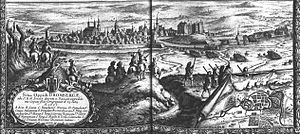 Bromberg (Bydgoszcz) in 1657 | |
| Type | Military alliance Legal status of the Duchy of Prussia, Lauenburg and Bütow Land, Draheim (Drahim) and Elbing (Elbląg) |
|---|---|
| Signed | 6 November 1657 |
| Location | Bromberg (Bydgoszcz), Poland |
| Expiration | 1773 |
| Signatories | |
| Parties | |
| Language | Latin |
The Treaty of Bromberg (German: Vertrag von Bromberg, Latin: Pacta Bydgostensia) or Treaty of Bydgoszcz was a treaty between John II Casimir of Poland and Elector Frederick William of Brandenburg-Prussia that was ratified at Bromberg (Bydgoszcz) on 6 November 1657. The treaty had several agreements, including the Treaty of Wehlau, signed on 19 September 1657 by the Brandenburg–Prussian and Polish–Lithuanian envoys in Wehlau (Welawa, now Znamensk). Thus, the Treaty of Bromberg is sometimes referred to as treaty of Wehlau-Bromberg or Treaty of Wehlau and Bromberg (Polish: traktat welawsko-bydgoski).
In exchange for military aid in the Second Northern War and the return of Ermland (Ermeland, Warmia) to Poland, the Polish king granted the Hohenzollern dynasty of Brandenburg hereditary sovereignty in the Duchy of Prussia, pawned Draheim (Drahim) and Elbing (Elbląg) to Brandenburg and handed over Lauenburg and Bütow Land to the Hohenzollerns as a hereditary fief.
The treaty was confirmed and internationally recognized in the Peace of Oliva in 1660. Elbing was kept by Poland, but Lauenburg and Bütow Land and Draheim were later integrated into Brandenburg-Prussia. The sovereignty in Prussia constituted the basis for the later coronation of the Hohenzollern as Prussian kings. Wehlau-Bromberg remained in effect until it was superseded by the Treaty of Warsaw (18 September 1773) after the First Partition of Poland. The Treaty of Bromberg later became regarded as one of the worst mistakes in Polish foreign policy towards Prussia after its consequences had become fatal to Poland.[1]
- ^ Miasta warmińskie w latach 1655-1663 Józef Włodarski Wyższa Szkoła Pedagogiczna w Olsztynie,page 62, 1993